Benty Grange hanging bowl
The Benty Grange hanging bowl is a fragmentary Anglo-Saxon artefact from the 7th century AD. All that remains are two escutcheons; a third disintegrated soon after excavation, and no longer survives. The escutcheons were found in 1848, alongside the better-known Benty Grange helmet, by the antiquary Thomas Bateman in a tumulus at the Benty Grange farm in Derbyshire. They were undoubtedly buried as part of an entire hanging bowl, placed in what appears to have been the burial mound of a high-status warrior.
| Benty Grange hanging bowl | |
|---|---|
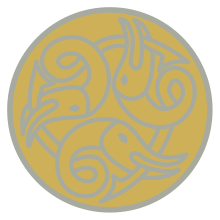 Reconstructed escutcheon design | |
| Material | Bronze, enamel |
| Discovered | 1848 Benty Grange farm, Monyash, Derbyshire, England 53.174895°N 1.782923°W |
| Discovered by | Thomas Bateman |
| Present location | Weston Park Museum, Sheffield; Ashmolean Museum, Oxford |
| Registration | J93.1190; AN1893.276 |
What remains of one escutcheon belongs to Museums Sheffield and in 2018 was displayed at Weston Park Museum.[1] The other is held by the Ashmolean Museum at the University of Oxford; as of 2020 it is not on display.[2]
Description
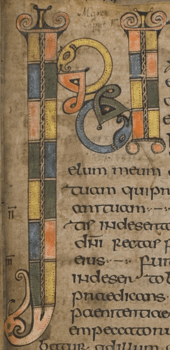
The two surviving escutcheons are made of enamelled bronze and are 40 mm (1.6 in) in diameter.[3] They have the same design and plain frames, parts of which survive.[3] Both escutcheons are fragmentary; enough survives of each for the design to be reconstructed,[3] and, because of overlapping segments, for it to be certain that they represent two distinct pieces.[4] Whether they are hook escutcheons, associated with the suspension hooks on the exterior of the bowl, or basal discs, placed at the base of the interior, is uncertain, but a ring on the back of one fragment suggests an association with the suspension chains, and a contemporary watercolour by Llewellynn Jewitt seems to show that a hook may have been present at excavation.[3] The decomposed enamel background appears yellow to the eye,[5] as it did when excavated.[6][7][8] A yellow-creatures-on-red-background colour scheme has also been suggested,[9][10] but on minimal and possibly incorrect evidence.[5] As sampling of the enamel was not permitted when the Sheffield escutcheon was analysed at the museum in 1968, however, the all-yellow hypothesis is not definitive.[11][note 1]
The reconstructed design shows three "ribbon-style fish or dolphin-like creatures", each biting the tail of the animal ahead of it.[3] The bodies are yellow like the background, and defined by their outlines.[4] They are limbless, the tails curled in a circle, and the jaws both long and curved; where the tails should pass through the jaws of the animals behind, gaps appear, creating slight separations between segments of tail.[3] Each animal has a small eye shaped like a pointed oval.[3] The outer borders of the discs, the plain frames, and the contours and eyes of the animals, are all tinned or silvered.[3]
Surviving records of the third escutcheon indicate that it was of a different style and size.[3][4] Drawings by Bateman and Jewitt show it with a scroll pattern and small piece of frame.[4][6][15] It appears to have been about half the size of the other two, and may have originally been placed at the bottom of the hanging bowl.[3]
The escutcheons were undoubtedly part of an entire hanging bowl when buried.[3] Nothing else survives.[3] The mass of corroded chainwork discovered six feet away, which survives only in illustrations by Jewitt and descriptions by Bateman,[16][17] is unlikely to be related; although a large and intricate chain was found with a cauldron from Sutton Hoo, the Benty Grange chains appear dissimilar.[18] The Benty Grange chainwork was also likely too heavy to have been used to suspend the hanging bowl.[18]
Parallels
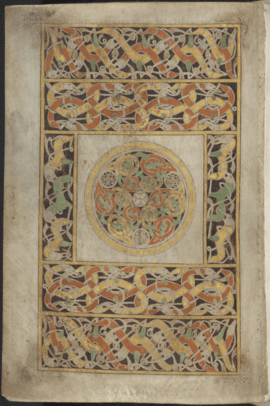
The animal designs on the Benty Grange hanging bowl are paralleled by designs on other escutcheons, and even more closely by designs on medieval illuminated manuscripts.[9][19] Three escutcheons from a hanging bowl found in Faversham show animals that also look like dolphins,[20][21][22] but with more developed bodies;[19] a better parallel is with a disc found near the Lullingstone hanging bowl that is also decorated with dolphin-like creatures.[23][24]
Despite the similarities with other escutcheon and disc designs, several manuscript illustrations are more closely related to the Benty Grange designs.[19] Bateman remarked on this as early as 1861, "shrewdly" as it turned out,[25] noting that similar patterns were used in "several manuscripts of the VIIth Century, for the purpose of decorating the initial letters".[8] Anglo-Saxon metalwork designs like those on the Benty Grange escutcheons may have inspired aspects of the manuscript art.[26][27] In particular, the mid-seventh-century Durham Gospel Fragment contains two similar fish-like motifs contained within the lateral stroke of the INI monogram that introduces the Gospel of Mark.[4][28] The Book of Durrow also contains a similar illustration of linked yellow dolphin-like creatures.[26][27]
Discovery
Location
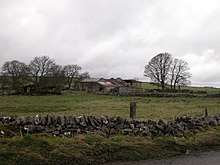
The hanging bowl was discovered in a barrow on the Benty Grange farm in Derbyshire,[29] in what is now the Peak District National Park.[30] Thomas Bateman, an archaeologist and antiquarian who led the excavation,[note 2] described Benty Grange as "a high and bleak situation";[29] its barrow, which still survives, is prominently located by a major Roman road,[33] now the A515, possibly to display the burial to passing travellers.[34] It may have also been designed to share the skyline with two other nearby monuments, Arbor Low stone circle and Gib Hill barrow.[34]
The seventh-century Peak District was a small buffer state between Mercia and Northumbria, occupied, according to the Tribal Hidage, by the Anglo-Saxon Pecsæte.[35][36] The area came under the fold of the Mercian kingdom around the eighth century;[36] the Benty Grange and other rich barrows suggest that the Pecsæte may have had their own dynasty beforehand, but there is no written evidence for this.[35]
Excavation
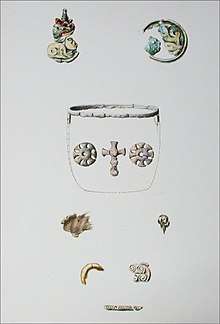
Bateman excavated the barrow on 3 May 1848.[29] Although he did not mention it in his account, he was likely not the first person to dig up the grave.[37] The fact that the objects were found in two clusters separated by 6 ft (1.8 m), and that other objects that normally accompany a helmet were absent, such as a sword and shield,[38] suggests that the grave had previously been looted.[37] Being so large it may alternatively or additionally have contained two burials, only one of which was discovered by Bateman.[39][note 3]
The barrow comprises a circular central mound approximately 15 m (50 ft) in diameter and 0.6 m (2 ft) high, an encircling fosse about 1 m (3.3 ft) wide and 0.3 m (1 ft) deep, and outer penannular earthworks around 3 m (10 ft) wide and 0.2 m (0.66 ft) high.[39] The entire structure measures approximately 23 by 22 m (75 by 72 ft).[39] Bateman suggested a body once lay at its centre, flat against the original surface of the soil, of which little remained;[29][41] what he described as the one remnant, strands of hair, is now thought to be from a cloak of fur, cowhide or something similar.[42] The recovered objects were found in two clusters.[37][43][44] One cluster was found in the area of the supposed hair, the other about 6 ft (1.8 m) to the west.[43][44] In the latter area Bateman described "a large mass of oxydized iron" which, when removed and washed, presented itself as a jumbled collection of chainwork, a six-pronged piece of iron resembling a hayfork, and the Benty Grange helmet.[45][46][47]
In the area of the supposed hair, Bateman described "a curious assemblage of ornaments", which were difficult to remove successfully from the hardened earth.[29][43] This included a cup identified as leather but probably of wood,[48][49] approximately 3 in (7.6 cm) in diameter at the mouth.[29][6] Its rim was edged with silver,[29] while its surface was "decorated by four wheel-shaped ornaments and two crosses of thin silver, affixed by pins of the same metal, clenched inside".[8] Also found were "a knot of very fine wire", some "thin bone variously ornamented with lozenges &c." attached to silk, but that soon decayed when exposed to air, and the Benty Grange hanging bowl.[6][15][25] As Bateman described it
The other articles found in the same situation are principally personal ornaments, of the same scroll pattern as those figured at page 25 of the Vestiges of the Antiquities of Derbyshire;[50]—of these enamels, there were two upon copper, with silver frames; and another of some composition which fell to dust almost immediately: the prevailing colour in all is yellow.[6]
Bateman closed his 1848 account of the excavation by noting the "particularly corrosive nature of the soil",[51] which by 1861 he said "has generally been the case in tumuli in Derbyshire".[52] He suggested that this was the result of "a mixing or tempering with some corrosive liquid; the result of which is the presence of thin ochrey veins in the earth, and the decomposition of nearly the whole of the human remains."[52] Bateman's friend Llewellynn Jewitt, an artist and antiquarian who frequently accompanied Bateman on excavations,[53] painted four watercolours of the finds, parts of which were included in Bateman's 1848 account.[54][note 4] This was more than Jewitt produced for any other of their excavations, a mark of the importance that they assigned to the Benty Grange barrow.[54]
The hanging bowl entered the extensive collection of Bateman. On 27 October 1848 he related his discoveries, including the helmet, cup, and hanging bowl, to the British Archæological Association,[56][57][58] and in 1855 they were catalogued along with other objects from the Benty Grange barrow.[59] In 1861 Bateman died at 39,[32] and in 1876 his son, Thomas W. Bateman, loaned the collection to Sheffield.[60] It was displayed at the Weston Park Museum through 1893, at which point the younger Bateman, having seen to his father's fortune, was forced to sell by order of chancery.[61][62] The city purchased many of the objects that had been excavated in Yorkshire, Derbyshire, and Staffordshire, including the helmet, the cup fittings, and one of the hanging bowl escutcheons; other pieces were dispersed by Sotheby's,[62][63] and later in 1893 the second escutcheon was presented to the Ashmolean Museum by Sir John Evans.[64] As of 2020, the escutcheons remain in the collections of the two museums.[1][64]
The Benty Grange barrow was designated a scheduled monument on 23 October 1970.[39] The list entry notes that "[a]lthough the centre of Benty Grange [barrow] has been partially disturbed by excavation, the monument is otherwise undisturbed and retains significant archaeological remains."[39] It goes on to note that further excavation would yield new information.[39] The nearby farm was renovated between 2012 and 2014;[65][66] as of 2018 it is rented out as a holiday cottage.[67]
Publication
Bateman published an article on the Benty Grange excavation in October 1848—five months after excavating the barrow—in The Journal of the British Archaeological Association.[68] The finds were included in his 1855 catalogue of his collection,[69] and shortly before his death, Bateman revised and expanded upon his 1848 account in his 1861 book Ten Years' Digging in Celtic and Saxon Grave Hills.[70] Similarly, Llewellynn Jewitt commented upon the finds, including the hanging bowl, in his 1870 book Grave-mounds and their Contents.[71]
The hanging bowl was one of the first to be discovered, and in 1898 John Romilly Allen included it among 16 examples in the first English article to discuss hanging bowls as a distinct class of artefact.[72][73] It was frequently mentioned in the literature thereafter,[19] including reconstructions by T. D. Kendrick in 1932 and 1938,[74][26] Françoise Henry in 1936,[75] Audrey Ozanne in 1962–1963,[76] and George Speake in 1980.[77] Rupert Bruce-Mitford revisited the Benty Grange burial in 1974,[78], and published what he termed a "definitive" reconstruction of the escutcheons in 1987;[79] in his posthumous 2005 work A Corpus of Late Celtic Hanging-Bowls he added a full description of the hanging bowl, and a reconstruction in colour of the escutcheons.[80]
Notes
- The Benty Grange escutcheons are some of the very few to have yellow rather than red enamel.[12][13] Many that appear yellow in fact contain deteriorated red enamel; such enamel tends to be chalky or powdery instead of glassy, however, and visibly red enamel may remain underneath.[12][14] Although Rupert Bruce-Mitford was unable to sample the enamel when he analyzed the Sheffield escutcheon, he wrote that "[n]o slightest trace of red can be detected in the depths or fractures of the background or the body-filling so far as these are visible".[11] Noting the bodies "are certainly yellow", he termed the all-yellow colour scheme "a working hypothesis".[11] Otherwise, they would likely be yellow-on-red.[11]
- Bateman excavated more than 500 barrows in his lifetime, earning him the moniker "The Barrow Knight."[31][32]
- Llewellynn Jewitt suggested there were two burials in 1870, writing that "In this mound, although a curious and unique helmet, the silver mountings of a leather drinking-cup, some highly interesting and beautiful enamelled ornaments, and other objects, as well as indications of the garments, remained, not a vestige of the body, with the exception of some of the hair, was to be seen. The lovely and delicate form of the female and the form of the stalwart warrior or noble had alike returned to their parent earth, leaving no trace behind, save the enamel of her teeth and traces of his hair alone, while the ornaments they wore and took pride in, and the surroundings of their stations, remained to tell their tale at this distant date."[40]
- The four watercolours are now in the collection of the Weston Park Museum.[54][16][17][55]
References
- Museums Sheffield escutcheon.
- Ashmolean Museum.
- Bruce-Mitford 2005, p. 119.
- Bruce-Mitford 1974, p. 250 n.5.
- Bruce-Mitford 2005, pp. 77, 119.
- Bateman 1848, p. 277.
- Bateman 1855, p. 160.
- Bateman 1861, p. 29.
- Henry 1936, p. 236.
- Haseloff 1990, p. 162.
- Bruce-Mitford 2005, p. 77.
- Brown 1981, pp. 230–231.
- Bruce-Mitford 2005, pp. 76–77.
- Bruce-Mitford 2005, p. 76.
- Bateman 1861, pp. 29–30.
- Museums Sheffield chainwork 1.
- Museums Sheffield chainwork 2.
- Bruce-Mitford 1974, p. 250 n.6.
- Bruce-Mitford 2005, p. 120.
- British Museum Faversham 1.
- British Museum Faversham 2.
- British Museum Faversham 3.
- Bruce-Mitford 2005, pp. 72, 120, 175, 428.
- Vierck 1970, p. 45.
- Bruce-Mitford 1974, pp. 224–225.
- Kendrick 1938, p. 100.
- Haseloff 1958, pp. 87–88.
- Bruce-Mitford 1987, p. 37.
- Bateman 1861, p. 28.
- Lester 1987, p. 34.
- Goss 1889, p. 176.
- Howarth 1899, p. v.
- Ozanne 1962–1963, p. 35.
- Brown 2017, p. 21.
- Yorke 1990, pp. 9–12, 102, 106, 108.
- Keynes 2014, p. 312.
- Bruce-Mitford 1974, p. 229.
- Smith 1908, p. 68.
- Historic England Benty Grange.
- Jewitt 1870, p. 211.
- Bateman 1848, p. 276.
- Bruce-Mitford 1974, pp. 223, pl. 73.
- Bateman 1848, pp. 276–277.
- Bateman 1861, pp. 28–30.
- Bateman 1848, pp. 277–278.
- Bateman 1861, pp. 30–32.
- Bruce-Mitford 1974, pp. 225–227.
- Allen 1898, pp. 46–47, 47 n.a.
- Bruce-Mitford 1974, pp. 223, 223 n.4.
- Bateman 1848, p. 25.
- Bateman 1848, p. 279.
- Bateman 1861, p. 32.
- Goss 1889, pp. 170–171, 175–176, 249, 301.
- Museums Sheffield escutcheon watercolour.
- Museums Sheffield helmet watercolour.
- The Times 1848.
- The Morning Post 1848.
- The Ipswich Journal 1848.
- Bateman 1855, pp. 159–160.
- Howarth 1899, p. iii.
- Rushforth 2004, pp. 114–115.
- Howarth 1899, pp. iii–iv, 242.
- Rushforth 2004, p. 115.
- Ashmolean escutcheon.
- Peak District Applications 2012.
- BentyGrange Twitter 2014.
- Peak Venues Benty Grange.
- Bateman 1848.
- Bateman 1855.
- Bateman 1861.
- Jewitt 1870, pp. 211, 248–257, 260–261.
- Allen 1898, pp. 46–47.
- Bruce-Mitford 2005, p. 8.
- Kendrick 1932, p. 178.
- Henry 1936, p. 235.
- Ozanne 1962–1963, p. 21.
- Speake 1980, fig. 11c.
- Bruce-Mitford 1974.
- Bruce-Mitford 1987, pp. 35, 37.
- Bruce-Mitford 2005, pp. 119–120, pl. 3b.
Bibliography
| Wikimedia Commons has media related to Benty Grange hanging bowl. |
- Allen, John Romilly (1898). "Metal Bowls of the Late-Celtic and Anglo-Saxon Periods". Archaeologia. LVI: 39–56. doi:10.1017/s0261340900003842.CS1 maint: ref=harv (link)

- "Anglo-Saxon Antiquities". The Times (20, 007). London. 30 October 1948. p. 4 – via Newspapers.com.

- "Anglo-Saxon Antiquities". The Morning Post (23, 370). London. 1 November 1848. p. 2 – via Newspapers.com.

- "Anglo-Saxon Antiquities". The Morning Post (5, 713). Ipswich. 4 November 1848. p. 4 – via Newspapers.com.

- Bateman, Thomas (1848). Vestiges of the Antiquities of Derbyshire and the Sepulchral Usages of its Inhabitants, from the Most Remote Ages to the Reformation. London: John Russell Smith.CS1 maint: ref=harv (link)

- Bateman, Thomas (October 1848). "Description of the Contents of a Saxon Barrow". The Journal of the British Archaeological Association. IV (3): 276–279. doi:10.1080/00681288.1848.11886866.CS1 maint: ref=harv (link)

- Bateman, Thomas (1855). A Descriptive Catalogue of the Antiquities and Miscellaneous Objects Preserved in the Museum of Thomas Bateman, at Lomberdale House, Derbyshire. Bakewell: James Gratton.CS1 maint: ref=harv (link)

- Bateman, Thomas (1861). Ten Years' Digging in Celtic and Saxon Grave Hills, in the counties of Derby, Stafford, and York, from 1848 to 1858; with notices of some former discoveries, hitherto unpublished, and remarks on the crania and pottery from the mounds. London: John Russell Smith. pp. 28–33.CS1 maint: ref=harv (link)

- Benty Grange [@BentyGrange] (22 August 2014). "We are proud to open the doors to Benty Grange to our first guests. We couldn't have done it without @PeakVenues . THANKS" (Tweet). Retrieved 10 February 2018 – via Twitter.

- "Benty Grange – Barn Conversion – Peak Venues". Peak Venues. Retrieved 10 February 2018.

- Brown, Antony (October 2017). "Dowlow Quarry ROMP Environmental Statement Appendix 10.2: Setting Assessment" (PDF). ARS Ltd Reports. 2017 (82). Archived from the original (PDF) on 10 February 2018.CS1 maint: ref=harv (link)

- "Escutcheon of hanging bowl". Ashmolean Museum of Art and Archaeology. Retrieved 29 March 2020.

- Brown, David (1981). "Swastika Patterns". In Evison, Vera Ivy (ed.). Angles, Saxons, and Jutes: Essays Presented to J. N. L. Myres. Oxford: Clarendon Press. pp. 227–240. ISBN 978-0-19-813402-2.CS1 maint: ref=harv (link)
- Bruce-Mitford, Rupert (1974). Aspects of Anglo-Saxon Archaeology: Sutton Hoo and Other Discoveries. London: Victor Gollancz. ISBN 978-0-575-01704-7.CS1 maint: ref=harv (link)
- Bruce-Mitford, Rupert (1987). "Ireland and the Hanging Bowls—A Review". In Ryan, Michael (ed.). Ireland and Insular Art, A.D. 500–1200: Proceedings of a Conference at University College Cork, 31 October-3 November 1985. Dublin: Royal Irish Academy. pp. 30–39. ISBN 978-0-901714-54-1.CS1 maint: ref=harv (link)
- Bruce-Mitford, Rupert (2005). Taylor, Robin J. (ed.). A Corpus of Late Celtic Hanging-Bowls with An Account of the Bowls Found in Scandinavia. Oxford: Oxford University Press. ISBN 978-0-19-813410-7.CS1 maint: ref=harv (link)
- "Escutcheon of hanging bowl". Ashmolean Museum of Art and Archaeology. University of Oxford. Retrieved 31 July 2018.

- Fowler, Elizabeth (1968). "Hanging Bowls". In Coles, John Morton & Simpson, Derek Douglas Alexander (eds.). Studies in Ancient Europe: Essays Presented to Stuart Piggott. Leicester: Leicester University Press. pp. 287–310.CS1 maint: ref=harv (link)
- "Fragments of enamelled escutcheon from Benty Grange". I Dig Sheffield. Museums Sheffield. Retrieved 31 July 2018.

- Goss, William Henry (1889). The Life and Death of Llewellynn Jewitt, F.S.A., Etc., with Fragmentary Memoirs of Some of his Famous Literary and Artistic Friends, Especially of Samuel Carter Hall, F.S.A., Etc. London: Henry Gray.CS1 maint: ref=harv (link)

- "hanging bowl". The British Museum Collection Online. The British Museum. Retrieved 2 August 2018.

- "hanging bowl". The British Museum Collection Online. The British Museum. Retrieved 2 August 2018.

- "hanging bowl". The British Museum Collection Online. The British Museum. Retrieved 2 August 2018.

- Haseloff, Günther (1958). Translated by de Paor, Liam. "Fragments of a Hanging-Bowl from Bekesbourne, Kent, and Some Ornamental Problems" (PDF). Medieval Archaeology. 2: 72–103. doi:10.1080/00766097.1958.11735474.CS1 maint: ref=harv (link)

- Haseloff, Günther (1990). Email im frühen Mittelalter: Frühchristiliche Kunst von der Spätantike bis zu den Karolingern (in German). Marburg: Hitzeroth. ISBN 978-3-89398-020-8.CS1 maint: ref=harv (link)
- Henry, Françoise (31 December 1936). "Hanging Bowls". The Journal of the Royal Society of Antiquaries of Ireland. 7th series. VI (II): 209–246. JSTOR 25513828.CS1 maint: ref=harv (link)

- Henry's original drawing available at "Sketch of Benty Grange escutcheon". UCD Digital Library. University College Dublin. Retrieved 2 April 2020.

- Henry's original drawing available at "Sketch of Benty Grange escutcheon". UCD Digital Library. University College Dublin. Retrieved 2 April 2020.
- Historic England. "Benty Grange hlaew, Monyash (1013767)". National Heritage List for England. Retrieved 10 February 2018.

- Howarth, Elijah (1899). Catalogue of the Bateman Collection of Antiquities in the Sheffield Public Museum. London: Dulau and Co.CS1 maint: ref=harv (link)

- Jewitt, Llewellynn (1870). Grave-mounds and their Contents: A Manual of Archæology, as Exemplified in the Burials of the Celtic, the Romano-British, and the Anglo-Saxon Periods. London: Groombridge and Sons.CS1 maint: ref=harv (link)

- Kendrick, T. D. (June 1932). "British Hanging Bowls". Antiquity. VI (22): 161–184. doi:10.1017/S0003598X00006700.CS1 maint: ref=harv (link)

- Kendrick, T. D. (1938). Anglo-Saxon Art to A.D. 900. London: Methuen & Co. Ltd.CS1 maint: ref=harv (link)

- Keynes, Simon (2014). "Mercia". In Lapidge, Michael; Blair, John; Keynes, Simon & Scragg, Donald (eds.). The Wiley Blackwell Encyclopedia of Anglo-Saxon England (2nd ed.). Chichester: Blackwell Publishing. pp. 311–313. doi:10.1002/9781118316061.ch13. ISBN 978-0-470-65632-7.CS1 maint: ref=harv (link)

- Lester, Geoff (Fall 1987). "The Anglo-Saxon Helmet from Benty Grange, Derbyshire" (PDF). Old English Newsletter. 21 (1): 34–35. ISSN 0030-1973.CS1 maint: ref=harv (link)

- Longley, David (1975). "Hanging-Bowls, Penannular Brooches and the Anglo-Saxon Connexion". British Archaeological Reports. 22.CS1 maint: ref=harv (link)
- Ozanne, Audrey (1962–1963). "The Peak Dwellers" (PDF). Medieval Archaeology. 6–7: 15–52.CS1 maint: ref=harv (link)

- Rushforth, Rebecca (2004). "The Barrow Knight, the Bristol Bibliographer, and a Lost Old English Prayer". Transactions of the Cambridge Bibliographical Society. XIII (1): 112–131. JSTOR 41154940.CS1 maint: ref=harv (link)

- Smith, Reginald Allender (1908). "Notes on Bronze Hanging-Bowls and Enamelled Mounts". Proceedings of the Society of Antiquaries of London. 2nd series. XXII: 63–86.CS1 maint: ref=harv (link)

- Speake, George (1980). Anglo-Saxon Animal Art. Oxford: Clarendon Press. ISBN 978-0-19-813194-6.CS1 maint: ref=harv (link)
- Vierck, Hayo (December 1970). "Cortina Tripodis. Zu Aufhängung und Gebrauch subrömischer Hängebecken aus Britannien und Irland". Frühmittelalterliche Studien (in German). 4: 8–52. doi:10.1515/9783110242041.8.CS1 maint: ref=harv (link)

- "Watercolour of finds from Benty Grange including escutcheon and cup fittings". I Dig Sheffield. Museums Sheffield. Retrieved 5 December 2018.

- "Watercolour Showing Fragments of Metal Chainwork". I Dig Sheffield. Museums Sheffield. Retrieved 3 August 2018.

- "Watercolour Showing Fragments of Metal Chainwork". I Dig Sheffield. Museums Sheffield. Retrieved 3 August 2018.

- "Watercolour showing the helmet from Benty Grange". I Dig Sheffield. Museums Sheffield. Retrieved 5 December 2018.

- "Weekly List of Applications Validated by the Authority: Applications validated between 18/072012 – 24/07/2012" (PDF). Peak District National Park Authority. Retrieved 10 February 2018.

- Yorke, Barbara (1990). Kings and Kingdoms of Early Anglo-Saxon England (PDF). London: Routledge. ISBN 978-0-203-44730-7. Archived from the original (PDF) on 2015-09-23. Retrieved 2020-03-29.CS1 maint: ref=harv (link)
